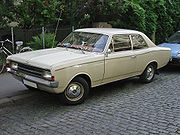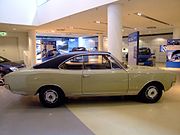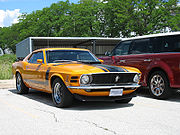- Coke bottle styling
-
Coke bottle styling is a term used to describe any automotive body styling bearing an overall body shape resembling the classic glass Coca-Cola soft drink's contour bottle design.[1] It is a style of automobile bodies with outward curving fenders with a narrow center.[2] In contrast to "straight-edge" designs, automobiles such as the sixth generation AMC Ambassador featured "swoopy lines ... in the 'Coke bottle' mode."[3]
Development
Studebaker introduced the Raymond Loewy-designed Avanti with pronounced Coke-bottle look in 1962.[4] That began the trend of Coke-bottle influence on automotive design of the 1960s. Chevrolet first tried the coke bottle look on Bill Mitchell's 1963 Corvette Sting Ray as a styling theme since the area rule does not apply at road speeds.[5] By 1966, A-body sedans and the Chevelle got a mid-riff pinch. The 1968 Corvette looked even more like a bottle bulging at both ends and a narrow middle. Intermediates such as the Pontiac Tempest, Dodge Charger, and Ford Torino soon followed suit, as well as compacts such as the Ford Maverick and Plymouth Duster. Notable automobiles with this style include many muscle cars such as the Pontiac GTO, Chevrolet Camaro, and Dodge Charger.[1]
As tailfins were influenced by jet aircraft of the 1950s, stylists such as Ford stylist Bill Shenk who designed the 1970 Ford Torino were inspired by supersonic aircraft. Aircraft such as the F-102 were designed with narrow waists and bulging forward and rear fuselages to conform to the area rule to achieve supersonic speeds.[6]
Japanese, European and Australian sedans also adopted this style during the 1970s. The smallest car with this style is usually considered to be the 1967 Suzuki Fronte 360, which was less than 3 metres (10 ft) long.[7]
Not all cars displayed the full "plan-view" Coke bottle styling, with the waist narrowing. Some of them, like the British Ford Cortina Mark III achieved a similar "muscular" look in profile (i.e. side view) with the front wing curving up over the front wheel area and a much more pronounced curve over the rear wheel arch. The 1969-70 Mustang is another example of this rear wheel arch kick-up.
By the late 1970s and early 1980s, cars like the Ford Fairmont and Chrysler K-cars moved towards straight lines. The Audi 5000 and Ford Taurus led towards functional aerodynamic styling. The revived Dodge Charger and similar Dodge Avenger does not have a complete Coke bottle body, but they have a rear fender line evocative of the 2nd generation Dodge Charger.
Modern muscle cars like the Fifth-generation Chevrolet Camaro and Dodge Challenger also have coke-bottle styling.
Partial list of cars with Coke bottle styling
Opel Commodore A
 Opel Rekord C
Opel Rekord C
- AMC Javelin[8]
- AMC Rebel[9]
- Chevrolet Corvair
- Dodge Charger (B-body)
- Ford Cortina Mark III
- Ford Mustang 1969-70
- Ford Torino
- Ford Maverick
- Plymouth Duster
- Opel Commodore A
- Opel Rekord C
- Pontiac Firebird
- Pontiac GTO
- Studebaker Avanti[10]
- Suzuki Fronte 360 LC10
- Vauxhall Cresta PC
- Vauxhall Victor FD
- Vauxhall Viva HB
- GAZ-3111
References
- ^ a b Breitenstein, Jeff; Paiva, Troy (2004). Ultimate Hot Rod Dictionary: A-Bombs to Zoomies. MBI Publishing. p. 53. ISBN 9780760318232. http://books.google.com/books?id=OtKWmLLiuTgC&pg=PA53&dq=Coke+bottle+styling&hl=en. Retrieved 10 October 2010.
- ^ "Plymouth Belvedere and Plymouth Satellite: 1968 coke-bottle restyling". allpar.com. http://www.allpar.com/model/satellite.html. Retrieved 10 October 2010.
- ^ Auto Editors of Consumer Guide (17 July 2007). "1967-1969 AMC Ambassador DPL & SST 2-doors". auto.howstuffworks. http://auto.howstuffworks.com/1967-1969-amc-ambassador-dpl-and-sst.htm. Retrieved 10 October 2010.
- ^ Jedlicka, Dan. "1963-64 Studebaker Avanti". http://www.danjedlicka.com/classic_cars/studebaker_avanti.html. Retrieved 10 October 2010.
- ^ Mueller, Mike (2002). Chevelle. MotorBooks. ISBN 9780760314845.
- ^ Shenk, Bill (May/June 1995). "The Birth of the 1970 Ford Fairlane/Torino". The Fairlaner News. http://www.torinocobra.com/articles/birth_of_torino.htm. Retrieved 10 October 2010.
- ^ Ozeki, Kazuo (2007) (in Japanese). Suzuki Story: Small Cars, Big Ambitions. Miki Press. p. 30. ISBN 9784895225038.
- ^ Strohl, Daniel (July 2005). "Attack of the Welterweight". Hemmings Muscle Machines. http://www.hemmings.com/mus/stories/2005/07/01/hmn_feature4.html. Retrieved 10 October 2010.
- ^ Quella, Chad. "The Spirit Is Still Alive: American Motors Corporation 1954-1987: 1967". allpar.com. http://www.allpar.com/amc/. Retrieved 10 October 2010.
- ^ Auto Editors of Consumer Guide (17 December 2007). "1963-1964 Studebaker Avanti". auto.howstuffworks. http://auto.howstuffworks.com/1963-1964-studebaker-avanti.htm. Retrieved 10 October 2010.
Categories:- Automotive styling features
Wikimedia Foundation. 2010.






